QF 12 pounder 18 cwt naval gun
| Ordnance QF 12 pounder 18 cwt | |
|---|---|
|
Deployed as anti-aircraft gun on HMS Agamemnon off Salonika, 1916 | |
| Type | Naval gun |
| Place of origin | United Kingdom |
| Service history | |
| In service | 1906–192? |
| Used by | Royal Navy |
| Wars | World War I |
| Production history | |
| Designer | Elswick Ordnance Company |
| Designed | 189? |
| Specifications | |
| Weight | Gun & breech: 2,016 lb (914 kg) |
| Barrel length | Bore: 150 inch (3.81 m) (50 calibres) |
|
| |
| Shell | Separate QF 12.5 lb (5.66 kg) |
| Calibre | 3 in (76 mm) |
| Rate of fire | 20 rd/min[1] |
| Muzzle velocity | 2,600 ft/s (790 m/s)[2] |
| Effective firing range |
9,300 yards @ +20° (8,500 m @ +20°) |
The QF 12 pounder 18 cwt gun was a 3 inch high-velocity naval gun used to equip larger British warships such as battleships for defence against torpedo boats. 18 cwt referred to the weight of gun and breech (18 × 112 lb = 2,016 lb or 914 kg), to differentiate the gun from others that also fired the "12 pound" (actually 12.5 lb or 5.7 kg) shell.
Service
Royal Navy service
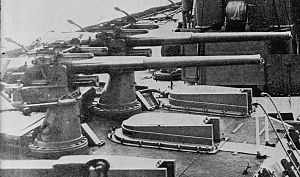
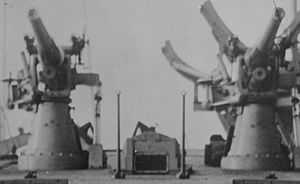
Guns were mounted in:[3]
- HMS Dreadnought commissioned 1906
- The last three King Edward VII-class battleships—HMS Britannia, HMS Africa, and HMS Hibernia, commissioned 1906–1907
- Lord Nelson-class battleships commissioned 1908
- Minotaur-class armoured cruisers commissioned 1908–1909
The gun was superseded in the anti-torpedo boat role on new capital ships from 1909 onwards by the far more powerful BL 4-inch Mk VII gun.
World War I land service

In World War I four guns were landed for service in the East Africa campaign, on 10 February 1916, and were used until September. They constituted the 9th Field Battery manned by Royal Marines. They were originally towed by oxen and later by Napier lorries.[4]
Ammunition
The gun fired the same 12.5 lb 3-inch (76 mm) shells as the other British "QF 12 pounder" guns, but used its own larger separate cartridge case to accommodate a larger quantity of cordite propellant.
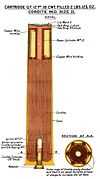 |
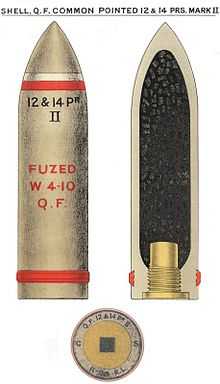 |
 |
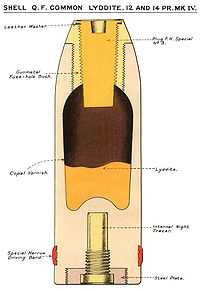 |
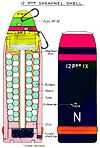 |
See also
Notes
- ↑ 20 rounds per minute is quoted in Elswick gun tables of 1901, and may be considered optimistic
- ↑ 2600 ft/s: Range Tables for His Majesty's Fleet, 1910 February, 1911 with 2 lb 12 oz (1.25 kg) cordite MD propellant. The gun first appears in Elswick gun Tables as quoted in Brasseys Naval Annual 1901 with a maximum muzzle velocity 2800 ft/s with "battering" charge of 3 lb cordite (Mk I), but this is not the charge adopted for British service.
- ↑ The Sight Manual 1916
- ↑ Farndale 1988, pages 316, 391. Farndale, quoting from the Official History, states they were from HMS Pegasus, but it did not carry these guns.
References
- General Sir Martin Farndale, History of the Royal Regiment of Artillery. The Forgotten Fronts and the Home Base, 1914–18. London: The Royal Artillery Institution, 1988.
- Tony DiGiulian, British 12-pdr (3"/50 (7.62 cm)) 18cwt QF Mark I
External links
| Wikimedia Commons has media related to QF 12 pounder 18 cwt naval gun. |
| ||||||||||||||||||||||||||||||||||||||||||||||||||||||
| ||||||||||||||||||||||||||||||||||||||||||||||||||||||||||||||||||||
